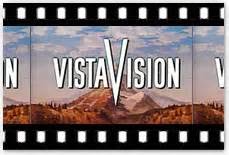
When Paramount introduced the process in 1954, the best way to see VistaVision was in one of the company's Lazy-8 Flagship theaters, where the movie would actually run through a projector horizontally and onto a 30 x 55-foot screen. Height rather than width was emphasized, and true VistaVision was meant to be viewed at 1.66:1.
A showing of White Christmas (1954), the first VistaVision film, began with a black-and-white newsreel on a screen that was masked to standard size by the stage curtains. After the newsreel, the words "Paramount Proudly Presents the First Picture in. . . ." appeared - at which point, a giant V filled the screen. Suddenly, the curtains parted, the stereo sound kicked in, and the full VistaVision logo came into view. Eventually, the White Christmas title, displayed on a deep red background, would explode across the entire screen. Audiences ate it up.
Bing Crosby, the star of White Christmas, once told me he felt that VistaVision was the real attraction of the show. Two years later, when he coproduced High Society (1956) at MGM, he adamantly insisted that the production be shot in VistaVision instead of CinemaScope. Alfred Hitchcock loved the process' quality and flexibility, and when he made a rare foray over to MGM, for 1959's wonderful North by Northwest, the Master of Suspense decreed that the production be lensed in VistaVision.
Even widescreen nemesis John Ford demanded VistaVision for The Searchers (1956), considered by many to be the best VistaVision film ever made. Though Paramount suggested that theaters project VistaVision films for general release in the standard widescreen 1.85:1 ratio, most laserdisc-version VistaVision titles are at 1.85:1, The Searchers disc is closer to 2.1:1.
Paramount/LDC's disc of Funny Face (1956), on the other hand, is letterboxed from original VistaVision elements to a 1.66:1 ratio. Though minor negative and camera scratches move across the frame (rather than up and down, as they would with a conventional vertical process), it's still one of the best-looking laserdiscs ever and remains an extraordinary reminder of the capabilities of this incredible process - essentially, the quality forerunner of IMAX.
As fine as it was, however, VistaVision was phased out after a scant 7 years. When it was decided that 1961's One Eyed Jacks would be the final VistaVision release, the brilliant cameraman William Daniels declared that he felt like going into mourning.